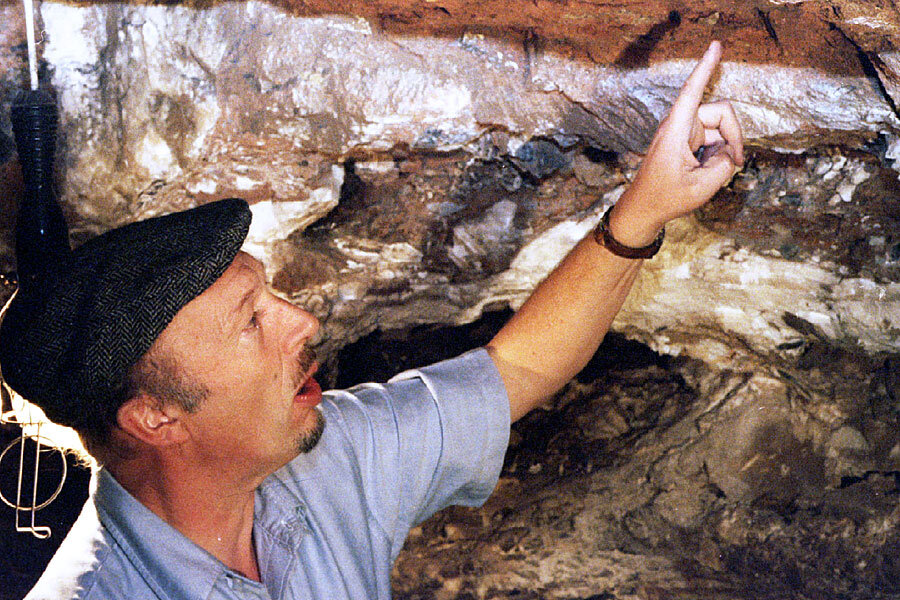Ancient hominid ‘Little Foot’ gets new birthdate
Loading...
Lucy and Little Foot, sitting in a cave…
An international team of researchers used new dating techniques to estimate the age of ‘Little Foot’ – a South African fossil specimen whose age has been debated for over two decades. At about 3.67 million years old, this specimen could have lived at the same time as Australopithecus afarensis, a more widely studied species that includes the famous ‘Lucy.’
The new estimate, published Wednesday in the journal Nature, could help identify the yet-unclassified Little Foot fossil – and sharpen the picture of human evolution.
In 1994, paleoanthropologist Ronald J. Clarke discovered Little Foot in an unusual place. Dr. Clarke, who also co-authored Wednesday's study, stumbled upon the specimen – a series of bone fragments from a diminutive left foot – not buried beneath layers of sediment, but packed away in museum boxes.
The fossils had been misattributed to an Old World monkey, but Clarke recognized them as distinctly hominid. Although near-complete skeletons are a rarity in paleontology, he returned to the excavation site in the Sterkfontein caves of Gauteng, South Africa. Remarkably, more fragments were found there – including pelvic bones, limbs, and a complete skull, all belonging to the same individual.
But while the skeleton is unusually complete, little else is known about it. Some researchers speculate that Little Foot is a member of Australopithecus afarensis or Australopithecus africanus; Clarke has argued that a more accurate placement would be within Australopithecus prometheus, a separate and highly-contested classification in itself.
Attempts to determine Little Foot’s age have been even less conclusive – previous age estimates have ranged from 1.7 million years to over 4 million years.
"Dating cave sediments and their fossils is difficult," co-author Darryl Granger writes in an e-mail interview. "We know so much about the timing of hominid evolution in East Africa because there are many datable volcanic ashes associated with the fossil sites. In places like South Africa there are no volcanic ashes to date. The cave sediments themselves can also be very complicated, with sediment falling into multiple entrances, collapsing into lower sections, and overlapping each other."
Dr. Granger, a professor at Purdue University’s Department of Earth, Atmospheric, and Planetary Sciences, spearheaded the effort to accurately date those sediments. One dating method, called cosmogenic nuclide burial dating, calculates the amount of cosmic rays that have struck the sediment to determine when it was first buried underground. Another measures the radioactive decay of uranium found in calcite cave formations, indicating when the calcite initially formed.
"The controversy of Little Foot largely comes because these two methods have disagreed," Granger said. "What [co-author] Ryan Gibbon and I have done is use improved instrumentation to make better measurements for burial dating, and combined this with a method known as ‘isochron’ burial dating to test whether the sediment surrounding the fossil was all buried at the same time. If it was all buried together, this strongly supports that the fossil is the same age as the sediment."
The new dating showed that the sediment was deposited around 3.7 million years ago – much earlier than the flowstone contained within it, which was dated at 2.2 million years. But this seeming-contradiction actually makes a good deal of sense, Granger says.
"They showed that the flowstone was formed inside cavities that were dissolved in the sediment after it was cemented," Granger said, "and so the flowstone must be younger than the sediment around it. So in a real sense both ages are right: the cosmogenic burial age gives the age of the sediment and the fossil, while the uranium-lead dating gives the age of the flowstone."
If Little Foot really was buried 3.7 million years ago, it implies that speciation occurred much earlier within Australopithecus – but Granger is careful to note that his work deals mostly in sediment dating. A more fossil-oriented study, led by Clarke, is forthcoming.
In the meantime, Clarke still places Little Foot within Australopithecus prometheus – a species "very different" from the more gracile Australopithecus afarensis, and more similar to the robust Paranthropus lineage.
"[The new dating] demonstrates that the later hominids – i.e. Australopithecus africanus and Paranthropus – did not all have to have derived from Australopithecus afarensis," Clarke said in a statement. "We only have a small number of sites and we tend to base our evolutionary scenarios on the few fossils we have from those sites. This new date is a reminder that there could well have been many species of Australopithecus extending over a much wider area of Africa."






